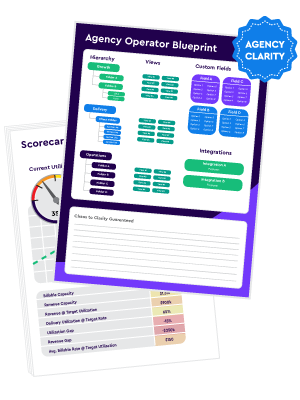On Change Management and Decision-Making in Crisis
On the show, Tiffany described a situation in which her agency, Element Three, was in dire straits.
She took us back to one of her breakthrough moments, by first setting the stage of what she was dealing with.
"We had a client churn rate that was not sustainable.
About half of our business was churning every year. Not in a project-heavy shop; we were losing clients because our work was not good.
Our culture was really suffering.
We were losing good talent because they weren't put on work that they felt successful at.
We were promising timelines that weren't effective or possible.
We were under-resourcing things.
We were undisciplined in our processes."
This forced her to make some tough decisions. And when she did so, she used a framework for communicating her decision that I found inspiring.
I asked:
"Tell me about the change management piece of it. Do you have any tips on how to actually make that change stick?"
To which she replied with this gem:
"I'll first start with a framework that I use when I'm communicating change that has worked in every area of my life.
And that is...
1. Do you understand it?
2. Do you agree with it?
3. And do you like it?
So, for instance, when we needed to get the business back on track, one of the imperatives was profit.
We had to make more money to be able to make the investment that we needed in professional development and all the stuff that we wanted to do.
And so a really hard choice that we had to make was, are we going to get slowly profitable? Or are we going to get profitable in a very short period of time on a quick turn?
And if we were going to get profitable in a very short period of time, it was going to require us to lay people off.
It's a really crappy day. It's a really crappy choice.
Both of them were not going to be fun.
But we made the decision to get profitable within a six week period of time, which meant that we were going to have to lay people off.
So you never want to do that as a leader.
It's a very bad day, but sometimes not doing it is a worse decision than doing it.
So, made the decision to lay some people off.
And when I needed to tell the company about that, I used this framework of: Do you understand it? Do you like it? Do you agree with it?
In that order.
So the first was to say: 'I want to outline for you. Let's imagine we're all in a Harvard business school and we're doing a case review. And so I'm going to outline for you the facts of the story.'
And I was like, here's our clients and here's their average spend and here's been our profitability as a business. These are our goals.
And this was the cash that we need in the business to be able to invest in these things that we know are important for our long-term ability to compete in the market and to get great talent and to pay you what you deserve and a bonus.
Like, this is the story. Here's the story.
Do you understand it?
And we spend time on just, do you understand it? Do you understand the numbers? Do you know what they mean? Do you know where they come from? Do you know what we mean by this word, does that make sense—attrition? Do you understand it?
You are not involved. Just imagine we're studying this. Do you understand it?
And as a result of this information, the decision is that we've let go of like six people.
Okay.
The second is, do you agree with it?
So imagine you are me. Imagine you're a leader in that situation. Given those state of facts, would you make the same or a different decision?
So again, I laid out for them, we had two choices to make.
We could have tried to get to profitability slowly. We thought that would take us six to nine months.
Or we could get to profitability quickly and it would take us six weeks. Here's why.
What would you choose? If you were in my seat, given this set of facts, what would you choose?
Do you agree with my choice?
And then the third is, put yourself back in your own chair.
Do you like it?
And what I would tell them is like, I understand the story. I understand the facts. It's my job to do that.
I agree with the choice that I've made—naturally—but I don't like it.
I don't like that I had to let people go.
I don't like that this is going to take us a while for our culture to rebuild trust in this area.
I don't like that we have to go have all these conversations with clients that some of their people aren't going to be... I don't like any of that.
And so we could unite in the fact that this is crappy, but we understand it and we agree that this is probably the best choice for the company long-term.
And what I was finding was happening is I'd be telling people what happened and they would say, essentially, I don't like it.
And it's like, well, I don't like it either, but I still need to be in the situation and I can give a chance to educate.
So that framework has been very helpful in meeting people intellectually with what is happening and why, so that they don't feel like this is random.
They don't feel like this is just some harebrained thing that I came up with.
And it allows us to teach them what the game that we're in, which is business.
So: Do you understand it? Do you agree with it? Do you like it?
That has been a very helpful framework for that initial conversation of like, hey, we've had to make a bad choice and let's get on the same page here."
The Only Fully Guaranteed Agency Operations Improvement Framework
Get 360 clarity into your operations or your money back, guaranteed.

On Vulnerability and Honesty in Leadership
Another key to turning her agency (and personal life) around was vulnerability, and having a real and honest look at her problems.
She emphasized the power of open communication about challenges faced in both personal and professional settings—because at the same time her agency was struggling, she was also experiencing a rough moment in her marriage.
She shared how she got through it:
"You've got to say it out loud to somebody who cares.
My husband and I had to say to each other: 'our marriage is not okay. This was not what I pictured. This sucks.'
And at the end of it, it's relieving because at least you can see it.
And then it's like, what's the decision that you're going to make?
In the case of the business, every single executive around that table had a choice to stay or leave.
Do you want to be part of this shit show or not?
And if you're going to leave, I'm not mad.
That's a choice you get to make.
If you're going to stay, this is what the work looks like."
This approach was the key to getting multiple areas of Tiffany's life back on track.
On Implementing Systems for Growth
Tiffany also discussed the importance of implementing and committing to systems for growth, highlighting the necessity of consistency and dedication to the strategies you choose.
Below, she talks about her thought process when she decided to go all-in on EOS:
"People spend 90 ounces of energy on deciding and 10 ounces of energy on implementing.
So, there's a lot of operating systems. There's more than EOS.
So, you can spend a bunch of time if you want to comparing them, figuring out which one is better, what meeting agenda do you like, what framework.
I just don't care. Pick one.
I'll just beat you because I'm going to be the best at one.
Think about marketing technology. There's a million.
Yes, some are better suited than others, but for most people, they don't need the 1% of technical difference.
Most people just don't use what they have well.
Think about diets. There's a lot that work. People just don't stick with it. They're really crappy at compliance.
I'm like, look, we're going to put 10 ounces of energy into the decision.
I had been around EOS for a little bit. I knew what their value proposition was. I knew what their promise was to entrepreneurs that essentially allow you to live life on your terms to make the money that you deserve from your business.
I was like, well, if I knew how to do all that stuff, I would already have it.
I don't know how to do that stuff.
People make casseroles.
They say, I like this tool from this thing. I like this tool from this thing. I like this tool from this thing.
It's like... Oh my word. Now you think you're smarter than the whole thing.
(...)
My personality is like, we're going to pick it, we're going to go and we're going to be the best and we're going to implement it all the way."
The more I interview leaders like Tiffany, the more I find that it really is all about the execution. This is yet example confirming, based on Tiffany's serious experience, that the way out of a tough spot is through action.There's Three More Things to Think Think About to Drive Your Agency's Growth
Execution is important, but you'll get way more mileage out of your elbow grease if you have a proper system for managing your work.
For that, you need to take care of the 3 Keys to gold-standard business operations:
- Processes
- Tools
- Habits
At ZenPilot, we've helped nearly 3,000 companies dial in all three to build happier teams and a more profitable business.
The foundation of it all is ClickUp—the best tool for managing all of your work in on place.
But ClickUp is extremely flexible—which is a problem when you want to just implement a robust, simple to use system that captures all of your tasks while keeping priorities clear for your team members.
Which is why we created ZenPilot's Ultimate Guide to ClickUp.
You can follow it to make your project management better than ever before.
Or... you can schedule a call with us, tell us about your ops problems, and get a custom ClickUp set up built for you, including team training and a ready-to-use database of ClickUp templates to get you started.
Schedule a call with ZenPilot here.
Cancel chaos.
Create clarity.
You can build a happier, more productive, more profitable team with ClickUp. We'll show you how.






